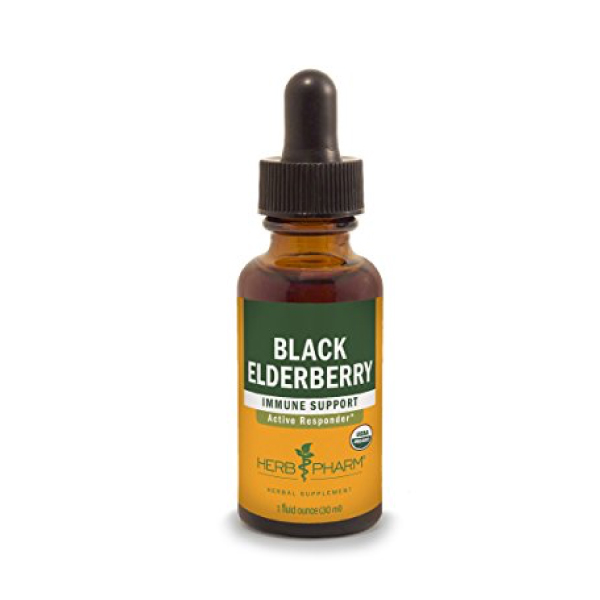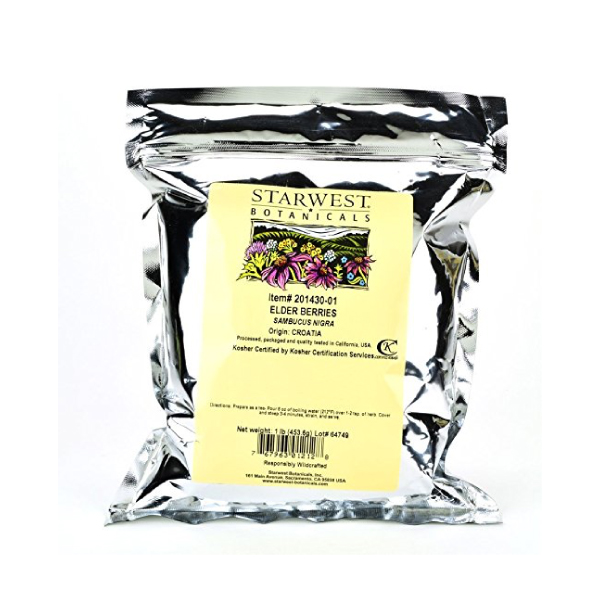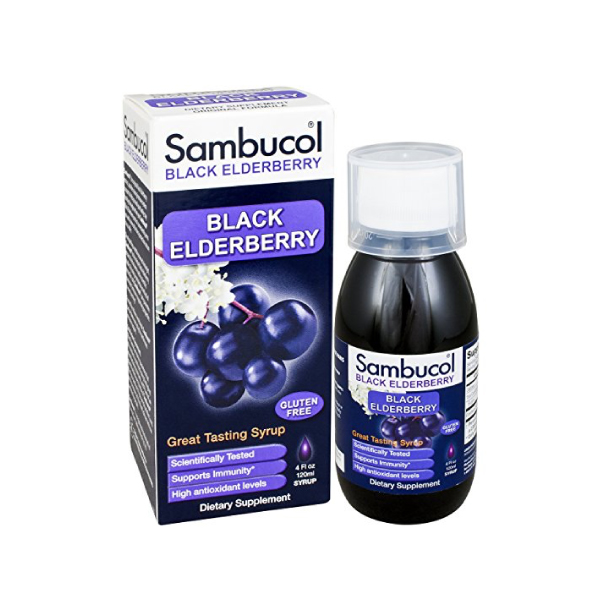What is Elderberry?
Elder is an invasive tree spread throughout most of the world.
It can be found in cold climates like Canada and Scandinavian countries, as well as tropical areas in Central and South America, Southeast Asia, and Australia.
Elder trees are even frequently found in remote areas like the Pacific Islands.
Elder has many uses, especially for upper respiratory infections for its antitussive and antiviral activity.
As an antiviral, it has a relatively narrow range of efficacy, which is specific to enveloped viruses like influenza, and will only have a potent effect in the early stages of viral infection. Elder is highly effective for early-stage viral infection and one of the best herbs to keep around in in the event of early signs of cold or flu.
Featured Elder Products
What is Elder Used For?
Elder is primarily used in the acute stage of respiratory infections. it has the unique ability to structurally inhibit the reproductive cycle of the influenza virus. If used in the early stages of infection elder can be used to prevent widespread infection.
elder is also used for its ability to interact with the central nervous system. For this effect, elder is often used for nerve-related pain.
Traditional Uses of Elder
The use of elder dates back a very long time. Evidence of elder seeds, pollen, and dried fruits have been found at a Bronze Age archaeological site in Tuscany (Italy) [12], a Neolithic site in the French Alps [13], and Durankulak site the Black Sea coast and north-eastern Bulgaria [13].
Elder is used in Ayurvedic medicine, but not in depth. Its berries are used primarily as a diuretic, and aperient, while the bark as a hydragogue, cathartic and anti-epileptic.
In traditional Chinese medicine, elder is known as "mao gu xiao" (Sambucus formosana or Sambucus chinensis) is used (rarely) to treat liver disease. It's considered to be a warm bitter, useful for dispelling blood stasis.
In Indonesia, elder (Sambucus javanica) is used for pain relief, beri beri, and jaundice.
In Western herbal medicine, elder is most commonly used to treat sore throats, and as a purgative or emetic. It's also used to treat wounds (the leaves mainly), or as a diuretic (whole plant).
Elder was commonly combined with herbs like yarrow or boneset in the treatmeent of cold and flu.
Herb Details: Elder
Herbal Actions:
- Antiviral
- Emetic (high doses)
- Antitussive
- Nervine (leaves)
Weekly Dose
- (1:2 Liquid Extract)
15-40 mL - View Dosage Chart
Part Used
Flowers and berries
In some cases the leaves, bark, and roots can also be used with caution.
Family Name
Caprifoliaceae
Distribution
Invasive the world over. Common in North America, Western Asia, Europe, The Pacific Islands, and Austalia.
Sambucus australasica and Sambucus gaudichaudiana (Australian white elder) are found primarily in Australia and South America.
Constituents of Interest
- Cyanidin-3-O-glucoside
- Ribosome-inactivating proteins (RIPs)
Common Names
- Elder
- Black Elder
- Elderberry
- European Elder
Botanical Information:
There are about 30 different species of elder, 3 of which are most commonly used as medicine. The common names for these species include blue elder (Sambucus nigra), red elder (Sambucus racemosa), and white elder (Sambucus australasica).
Phytochemistry
+ Constituent Breakdown:
Elder contains several hundred compounds.
This includes phosphorous (high), vitamins A, B6, and C.
Also contained are polyphenols, anthocyanins (blue-berries)(cyanidin 3-glucoside, cyanidin-3-sambubioside, cyanidin-3, 5-diglucoside, and cyanidin-3-sambubioside-5-glucoside), anthoxanthins (white berries), ribosome-inactivating proteins (RIPs) (TYPE 2 RIPs; nigrin b, basic nigrin b, SNA, SNA1, and SNLRP, nigrin f, nigrin s, ebulin 1, ebulin r1, ebulin r2. TYPE 1 RIPs; ebulitins), flavonol glycosides (quercetin-3-O-rutinoside, kaempferol-3-O-rutinoside and isorhamnetin-3-O-rutinoside (about 90% of the total flavonoid content)), phenolic acids (5-O-cafeoylquinic acid and 1,5-di-O-caVeoylquinic acid (about 70% of the total phenolic acid content)), triterpenoids (ursolic acid),
Key Compounds Found in Elder:
| Chemical class | Chemical Name | Pharmacology |
|---|---|---|
| Flavonoid pigments | Anthocyanins (S. nigra/canadensis) and anthoxanthins (S. australasica) | Water soluble flavonoids that are absorbed through the small intestine and reach peak concentration systemically after 30-60 minutes. They Remain mostly un metabolised before being excreted in the urine. |
| Flavonol glycosides | quercetin-3-O-rutinoside, kaempferol-3-O-rutinoside and isorhamnetin-3-O-rutinoside (about 90% of the total flavonoid content) | Some have been found to bind to viral membranes, possibly delivering main mechanism of actions through hemagglutinin, M2 ion channel, and neuraminidase inhibition. |
| Phenolic acids | 5-O-caVeoylquinic acid and 1,5-di-O-caVeoylquinic acid (about 70% of the total phenolic acid content). | Caffeoylquinic acids are mainly found in the plasma and urine as hydroxycinnamate metabolites. Research has suggested that most of the absorption is done in the upper GIT. Peak concentration varies greatly, ranging from 30 min to 6 hours (Tmax). |
| Triterpenes | Ursolic acid | Downregulates MMP-9 and inhibits COX-2. Reach peak concentration in the blood after 1 hour. Half life is 4 hours. |
| Lignans | Nigrin b, basic nigrin b, SNA, SNA1, and SNLRP, nigrin f, nigrin s, ebulin 1, ebulin r1, ebulin r2 (type 2 RIPs). ebulitins (Type 1 RIP) | RIPs have been shown to bind to viral envelop proteins, and have shown activity on sialic acid in the GIT (not confirmed in the repiratory epithelial tissue). The pharmacokinetics are not well understood. |
What's The Deal With Elders Toxicity Claims?
A group of compounds found in elder called lectins are closely related to the common rat poison — ricin.
Leptins are essentially proteins that can bind with sugars. If leptins like ricin get into the cells, they can interact with our ribosomes (the organelle that does most of the manufacturing of proteins and various other compounds).
The common name given to leptins like ricin that stop the ribosomes from working is referred to as "Ribosome-Inactivating Proteins" or RIPs for short.
RIPs are also thought to be protective against viruses and predators, as well as a way for the plant to store nitrogen.
Several RIPs have been isolated from black elder [18-20].
Similar lectin-compounds can be found in other medicinal plants with similar uses (antiviral), and limitations (emetic) — Phytolacca americana (Phytolacca antiviral protein or PAP).
There are three types of RIPs: Type 1, type 2, and type 3. [19, 20].
Both ebulin and ricin are type two RIPs.
How Elder Leptins Are Different Than Ricin
Despite structural similarities, elder isn't as toxic as ricin — and it's not as toxic as we once thought.
The Ld50 of ebulin 1 was 250 mg/kg, compared to ricins 0.023 µg/kg (intraperitoneal) and 0.0075 µg/kg (intravenous) [22] — that's a huge difference. You would essentially need more than 9000 times the dose of ebulin 1 compared to ricin to reach the same toxic dose.
There are some exceptions.
RIPs such as ebulin f and SELfd are toxic and resist breakdown in the stomach — leading to gastrointestinal irritation and upset.
The solution to this problem is to heat it before using it. The heat breaks reverse the ability for these RIPs to be broken down by pepsin in the stomach — thus preventing the toxic side-effects of ebulin f. [21, 25].
Clinical Applications Of Elder:
Elder is a great antiviral herb, especially for Influenza and some of the other enveloped viral species if used at the early stages of infection.
Cautions:
Elder is an emetic, especially in preparations that contain fresh plant material (unheated). If nausea occurs, dial back the dose. Contrary to popular belief elder is NOT poisonous. Emetics are frequently misinterpreted to be dangerously poisonous.
Elder is thought to decrease the effectiveness of morphine.
+ Contraindications
- Small children
- Caution advised with larger doses
Recent Blog Posts:
References:
Zakay-Rones, Z., Varsano, N., Zlotnik, M., Manor, O., Regev, L., Schlesinger, M., & Mumcuoglu, M. (1995). Inhibition of several strains of influenza virus in vitro and reduction of symptoms by an elderberry extract (Sambucus nigra L.) during an outbreak of influenza B Panama. The Journal of Alternative and Complementary Medicine, 1(4), 361-369. [in vitro]
Chen, C., Zuckerman, D. M., Brantley, S., Sharpe, M., Childress, K., Hoiczyk, E., & Pendleton, A. R. (2014). Sambucus nigra extracts inhibit infectious bronchitis virus at an early point during replication. BMC veterinary research, 10(1), 24. [in vitro]
Mascolo, N., Capasso, F., Menghini, A., & Fasulo, M. P. (1987). Biological screening of Italian medicinal plants for anti‐inflammatory activity. Phytotherapy research, 1(1), 28-31.[in vitro]
Yeşilada, E., Üstün, O., Sezik, E., Takaishi, Y., Ono, Y., & Honda, G. (1997). Inhibitory effects of Turkish folk remedies on inflammatory cytokines: interleukin-1α, interleukin-1β and tumor necrosis factor α. Journal of Ethnopharmacology, 58(1), 59-73. [in vtro]
Harokopakis, E., Albzreh, M. H., Haase, E. M., Scannapieco, F. A., & Hajishengallis, G. (2006). Inhibition of proinflammatory activities of major periodontal pathogens by aqueous extracts from elder flower (Sambucus nigra). Journal of periodontology, 77(2), 271-279. [in vitro]
Abuja, P. M., Murkovic, M., & Pfannhauser, W. (1998). Antioxidant and prooxidant activities of elderberry (Sambucus nigra) extract in low-density lipoprotein oxidation. Journal of Agricultural and Food Chemistry, 46(10), 4091-4096. Link. [in vitro]
Murkovic, M., Adam, U., & Pfannhauser, W. (2000). Analysis of anthocyane glycosides in human serum. Fresenius' journal of analytical chemistry, 366(4), 379-381. [in vitro].
Serkedjieva, J., Manolova, N., Zgórniak‐Nowosielska, I., Zawilińska, B., & Grzybek, J. (1990). Antiviral activity of the infusion (SHS‐174) from flowers of Sambucus nigra L., aerial parts of Hypericum perforatum L., and roots of Saponaria officinalis L. against influenza and herpes simplex viruses. Phytotherapy Research, 4(3), 97-100. [in vitro]
Konlee, M. (1998). A new triple combination therapy. Positive health news, (17), 12. [case report]
Ulbricht, C., Basch, E., Cheung, L., Goldberg, H., Hammerness, P., Isaac, R., ... & Weissner, W. (2014). An evidence-based systematic review of elderberry and elderflower (Sambucus nigra) by the Natural Standard Research Collaboration. Journal of dietary supplements, 11(1), 80-120. Link. [review article]
Christensen, L. P., Kaack, K., & Fretté, X. C. (2008). Selection of elderberry (Sambucus nigra L.) genotypes best suited for the preparation of elderflower extracts rich in flavonoids and phenolic acids. European Food Research and Technology, 227(1), 293-305. Link. Other.
Mariotti-Lippi, L.; Bellini, C.; Mori, S. Palaeovegetational reconstruction based on pollen and seeds/fruits from a bronze age archaeological site in Tuscany (Italy). Plant. Biosyst. 2010, 144, 902–908. [OTHER]
Martin, L.; Jacomet, S.; Thiebault, S. Plant economy during the Neolithic in a mountain context: The case of “Le Chenet des Pierres” in the french Alps (Bozel-Savoie, France). Veg. Hist. Archaeobot. 2008, 17, s113–s122. [OTHER]
Marinova, E.; Atanassova, J. Anthropogenic impact on vegetation and environment during the
Bronze Age in the area of Lake Durankulak, NE Bulgaria: Pollen, microscopic charcoal,
non-pollen palynomorphs and plant macrofossils. Rev. Palaeobot. Palynol. 2006, 141, 165–178. [OTHER]Mikulic-Petkovsek, M.; Schmitzer, V.; Slatnar, A.; Todorovic, B.; Veberic, R.; Stampar, F.; Ivancic, A. Investigation of anthocyanin profile of four elderberry species and interspecific hybrids. J. Agric. Food Chem. 2014, 62, 5573–5580. [Chemical profiling].
Ding, M.; Feng, R.; Wang, S.Y.; Bowman, L.; Lu, Y.; Qian, Y.; Castranova, V.; Jiang, B.H.; Shi, X. Cyanidin-3-glucoside, a natural product derived from blackberry, exhibits chemopreventive and chemotherapeutic activity. J. Biol. Chem. 2006, 281, 17359–17368.
Parikh, B.A.; Tumer, N.E. (2004). Antiviral activity of ribosome inactivating proteins in medicine. Mini Rev. Med. Chem. 2004, 4, 523–543.
Girbes, T.; Ferreras, J.M.; Arias, F.J.; Stirpe, F. Description, distribution, activity and phylogenetic relationship of ribosome-inactivating proteins in plants, fungi and bacteria. Mini Rev. Med. Chem. 2004, 4, 461–476.
Stirpe, F. Ribosome-inactivating proteins. Toxicon 2004, 44, 371–383.
Lapadula, W.J.; Sánchez Puerta, M.V.; Juri Ayub, M. Revising the taxonomic distribution, origin
and evolution of ribosome inactivating protein genes. PLoS One 2013, 8, e72825.Jiménez, P., Tejero, J., Cordoba-Diaz, D., Quinto, E. J., Garrosa, M., Gayoso, M. J., & Girbés, T. (2015). Ebulin from dwarf elder (Sambucus ebulus L.): a mini-review. Toxins, 7(3), 648-658. Link. [review article].
He, X.; McMahon, S.; Henderson, T.D.; Griffey, S.M.; Cheng, L.W. Ricin toxicokinetics and its sensitive detection in mouse sera or feces using immuno-PCR. PLoS One 2010, 5, e12858. [Animal study]
Iglesias, R.; Citores, L.; Ferreras, J.M.; Pérez, Y.; Jiménez, P.; Gayoso, M.J.; Olsnes, S.; Tamburino, R.; di Maro, A.; Parente, A.; et al. Sialic acid-binding dwarf elder four-chain lectin displays nucleic acid N-glycosidase activity. Biochimie 2010, 92, 71–80.
Vimr, E.; Lichtensteiger, C. To sialylate, or not to sialylate: that is the question. Trends Microbiol. 2002, 10, 254–257.
Jimenez, P.; Cabrero, P.; Basterrechea, J.E.; Tejero, J.; Cordoba-Diaz, D.; Girbes, T. Isolation and molecular characterization of two lectins from dwarf elder (Sambucus ebulus L.) blossoms related to the Sam n1 allergen. Toxins 2013, 5, 1767–1779



















As COVID-19 continues to spread around the world, we’re getting a lot of questions on what the potential role of herbal medicine is during the outbreak. Learn how the virus works and how to limit your chances of transmission.